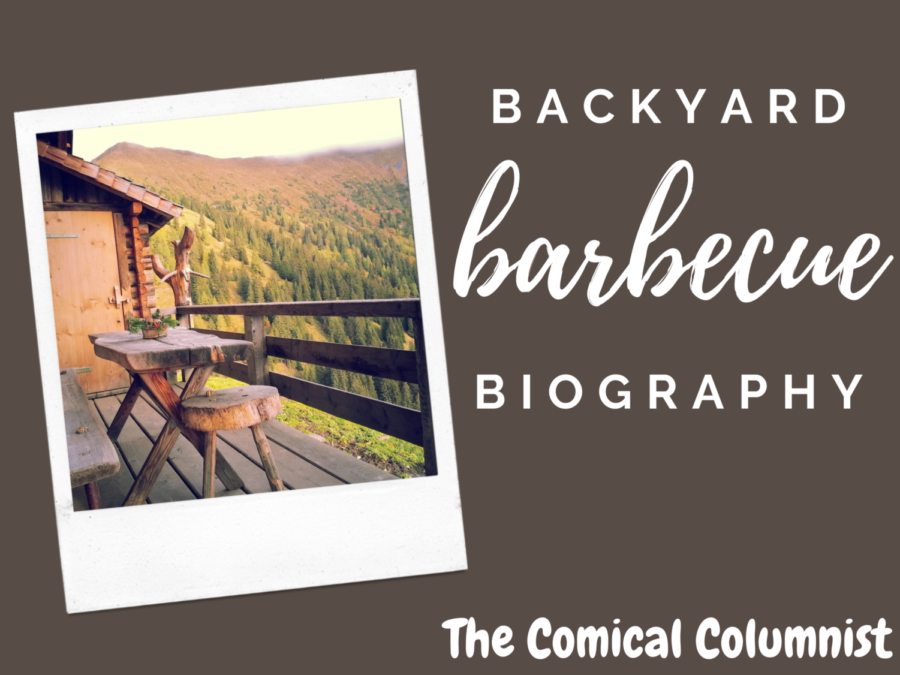The Comical Columnist: Backyard Barbecue Biography
There are many types of paved backyard areas, but the main ones in America are farmer’s porches, concrete patios, and attached decks.
November 17, 2021
Some of summer’s most memorable moments are at backyard barbecues, with the corn grilling, adults conversing and small children screaming their heads off. However, with all of those memories, it might be hard to remember what type of backyard space the host had; especially if you’re writing your soon-to-be-a-major-motion-picture autobiography, “My Life in Deck-ades”. There are many types of paved backyard areas, but if we explained all of them, your head would be spinning by the end of it. So, here are the top three.
In America, most homeowners have either farmer’s porches, concrete patios, or attached decks. A farmer’s porch is a classic type of porch, having a roof and support beams as well as railings. It’s long and narrow, going along the front of the house, adding to the width of it. They can also wrap around a whole house because some people are efficient with their resources—not to say that other people aren’t, but the wrap-around porch people on a whole new level over there. A farmer’s porch is typically attached to a farmer-type home, but now people add it to any type as it can be furnished in many different ways and can accommodate large groups of people—perfect for the endless goodbyes at the end of every single dinner party.
But, farmer’s porches have some problems that need to be addressed. Such as the narrow entrances at their fronts. No, I’m being serious here; I have a real bone to pick with them. They are the smallest things in existence. You might want to argue with me, saying that the smallest things in the world are actually atoms, quarks, planks, or whatever else your intelligent mind can reason, but you would be wrong. The covered roof is not worth it for these inefficient and suffocating openings.
Moving on: A concrete patio is essentially just a fancy slab of concrete attached to the backside of a house. It can come in many shapes and sizes to fit your aesthetic. It can also be either raised or level with the ground. Concrete patios can pretty easily be made at home but can turn out ten times better if done by a professional company, because, let’s face it, you probably don’t have a master’s degree in concrete slab construction.
Not everything is fine and dandy with concrete patios, though. They get hot. Like, really hot. Like, if I cracked an egg over one, it’d be ready to serve before you could say “Stop trying to make a point and get back inside!” You might think that creating a roof for it might solve this problem and that you can barbecue some green peppers and onions in peace, but if you don’t want to spend several hundreds or thousands of dollars on the structural integrity of the said roof, then we go back to the drawing board.
And finally, we have the attached deck. Simply put, they are farmer’s porches located in backyards. There’s not much to say about attached decks, other than how amazing they are. Attached decks can be level with the ground, or raised above it. And by raised, I mean up to two stories above the ground. Maybe not the best idea for people who have a fear of heights. Anyway, they can be screened-in or open to the infestation of varied insects that reside in Michigan. Attached decks are usually made of wood to provide the backyard with an “earthy” feel and they provide ample space for backyard barbecues.
Attached decks have some flaws that I don’t want to admit. Such as the cost, chance of termites, etc. They can be pretty costly as attached decks have to be able to bear a certain amount of weight, which can require a lot of wood. And because of this wood, it’s easier for termites to gnaw through the support. However, these things shouldn’t deter you from having the attached deck of your dreams.
In conclusion, attached decks are superb and have barely any flaws. Additionally, I might not be the best person to ask about backyards as I am an apartment-dwelling creature, but I hope that you have learned more about decks and will use this newfound knowledge in a positive way.







